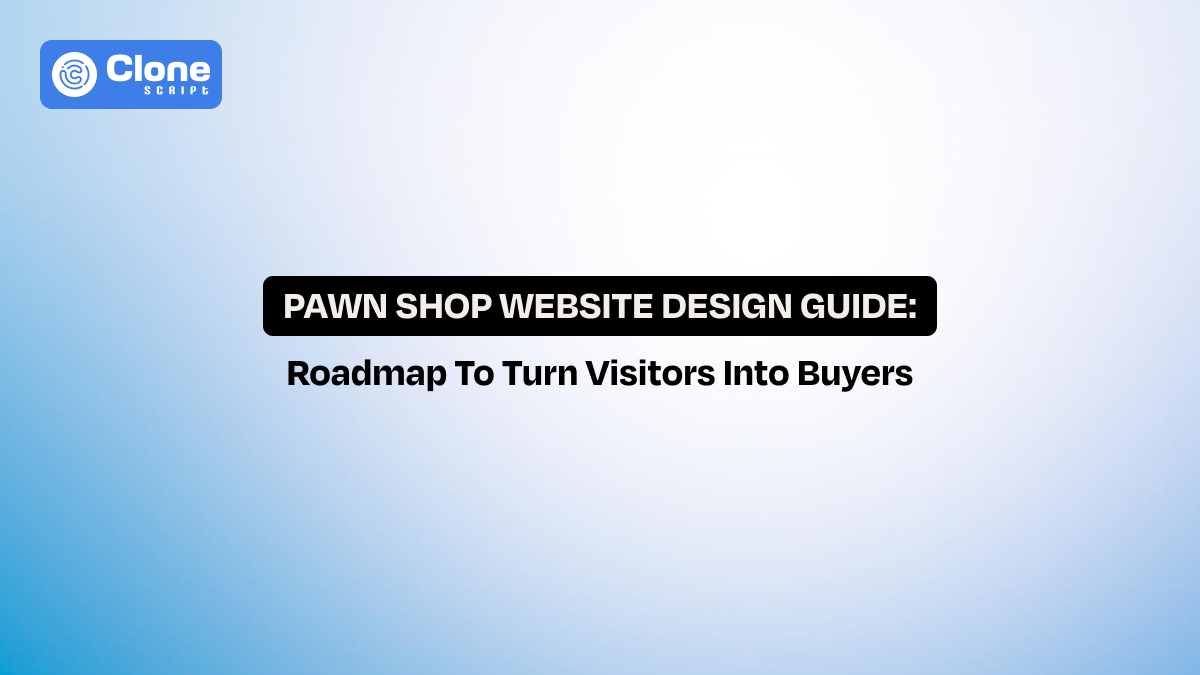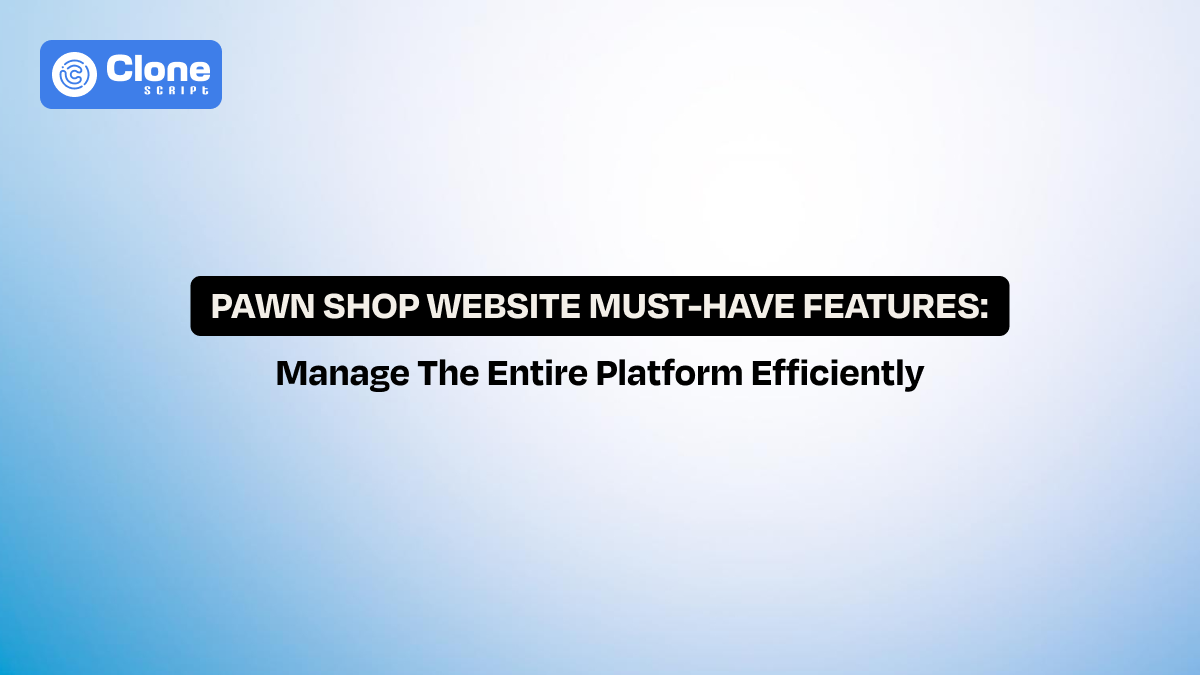Pawn Shop Website Design Guide: Turn Visitors into Buyers
The thing is simple: a well-crafted pawn shop website design can determine whether a customer chooses you or your competitor down the street. As this industry is built on trust and quick decisions, your site needs to do more than display inventory. It must inspire confidence, clearly explain your services, and guide visitors toward action.
This guide will help you understand what makes a website effective, how to design it for conversion, and how to implement pawn shop marketing strategies that bring in local customers. By the end, you’ll have the knowledge to turn visitors into buyers and browsers into believers.
Stats you may need to know
-
According to Stanford University’s Web Credibility Research, 94% of first impressions online are influenced by design.
-
A 2024 BrightLocal study reveals that 87% of consumers use Google to evaluate local businesses.
-
Research shows that 75% of people judge a business’s credibility based on its website design.
-
Authenticity in product presentation converts 35% better than generic imagery.
-
Studies show that a one-second delay in loading time can reduce conversions by 7%.
-
In 2025, over 68% of local business searches occur on mobile devices, according to Google.
Let’s start from the basics.
What is a Pawn Shop Website?
A pawn shop website is far more than an online listing of your services. It’s your virtual storefront and the face of your business. In a world where people research before they visit, your website represents your reputation, reliability, and professionalism.
Unlike typical retail sites, a pawn shop website must strike a careful balance—it must market your products and services while establishing credibility.
-
Customers visit your site looking for fast financial help, appraisals, or unique items, and they need immediate reassurance that you are a business they can trust.
So what makes it a strong pawn shop website design?
The answer is from layout and speed to the tone of your content; every element shapes customer trust.
The right design gives customers confidence to take the next step—whether that’s requesting a loan, calling for an appraisal, or visiting your store.
Why Does a Good Pawn Shop Website Matter for Your Business?
Modern consumers don’t just expect you to have a website. They expect it to work well. Here’s why a good, feature-rich pawn shop website matters more than ever:
1. Builds Credibility and Trust
Pawn transactions involve valuable items and sensitive information. This means you have to win the trust of your users. Through a clean, secure, and professional site appearance, it signals legitimacy, reassuring visitors they’re dealing with a reputable establishment.
2. Expands Your Reach
The pawn shop usually has a big place where multiple things and products are stored. There’s an issue arising with space to store items securely.
But with the website, you’re not just limited to only a single area of tehregion but you’re available online anywhere. From there, showcasing inventory, promoting deals, and answering questions before customers ever call is easy.
3. Increases Conversions
Websites designed by experienced web designers will help boost inquiries, calls, and local store visits. Strategic CTAs and persuasive copy encourage engagement. After all, your business success can be measured through the lead conversions. So, not having a convincing UI design is just like you’re not getting the potential users.
4. Reinforces Brand Identity
Be transparent and niche-expert. Make sure the website represents it. In other words, it has to reflect your brand in different segments, like
-
Luxury
-
Community-driven
-
Family-owned
Maintaining consistency across digital and physical spaces strengthens recognition and increases the brand’s Unique Selling Proposition (USP).
5. Supports SEO and Marketing Efforts
Do you think just having the best website design of a pawn platform is enough to draw the user's attention?
Not at all.
For that, you have to be involved in a digital marketing strategy, and website search engine optimization becomes more important in it.
With the best search optimization practices for your website, you create an opportunity to appear in local searches. This can help new customers find your pawn store instead of the competitors.
Ultimately, your website isn’t just a marketing channel. It’s an investment that continuously builds customer confidence and generates measurable results.
Now, you know what the best pawn shop website contains, but it’s incomplete without the user interface design elements.
Key Design Elements of a High-Converting Pawn Shop Website
A truly effective pawn shop website design combines usability, aesthetics, and psychology to influence decisions. Below are the key components of a high-performing design:
1. Simplified Navigation
“Keep it Simple, Make it Simple.” This is one of the best formulas in web design, most UX designers follow. As your visitors are often on a mission, either to sell, pawn, or buy.
Make sure your navigation is straightforward. Use clear menu titles like Home, Buy, Sell, Loans, About, and Contact. Keep the nested sections well-maintained, too, for making a chronology.
2. Professional Imagery
Having the best products in the store and flexible management skills is not enough for an online pawn shop. To convince the first-time visitors, focus on the impressive presentation, especially through visual media formats like photos, images, and short videos.
Authentic visuals build credibility, and it’s a speed booster for lead conversions. Showcase your store, team, and actual products instead of depending on stock photos.
3. Strategic CTAs
Most of the pawn store website visitors have the intention to visit the platform, whether it’s to sell the product or get a loan against the pledge. For that, call-to-action (CTA) buttons play a key role. Use action-oriented CTAs like “Get Cash Today” or “Request a Free Appraisal.”
Position them above the fold to maximize visibility. Once the users are notified, these buttons, without too many interactions they will likely accomplish the actions (e.g., loan request and contact).
4. Website Performance
Just think your website design is convincing from the homepage to the checkout page. But the problem is that it is stuck in the mobile phones. This results in the loss of most of the potential users.
To prevent these issues, your site has to perform well on the search engines with a fast-loading speed. It is website speed optimization can be done by compressing images and using a lightweight pawn shop website design template for optimal performance.
5. Security Features
This is considered the website development part, not related to UI design. As customers are doing online transactions like buying and selling items on your platform, the security maintenance is your responsibility.
By displaying SSL certificates and trusted payment logos prominently, customers can have assurance that transactions and personal information are protected.
6. Consistent Branding
The best pawn website is well-maintained a professional appearance for branding. So, you have to keep the consistency in color palette, typography, and tone. All should match your in-store branding. A cohesive design represents trust and a genuine brand.
Each of these design choices impacts how customers perceive your business and how confidently they act.
How to Create Trust with Your Website Design?
Trust is the foundation of every successful pawn transaction. A visitor won’t pawn their valuables with a business that feels uncertain. Here’s how to make trust the cornerstone of your design:
1. Showcase Testimonials and Reviews
This is very important to justify your services and your dedication to the business. Create a dedicated section on the site and feature real customer experiences. Positive reviews act as social proof, showing potential clients that others have had honest, successful interactions with your shop.
2. Introduce Your Team
Display staff photos and short bios. When customers see real people behind the counter, they feel more comfortable engaging with your business. Don’t use non-existent persons and spread false information about their expertise. Maintain transparency always.
3. Use Honest, Transparent Copy
Avoid aggressive marketing. Instead, communicate empathy and expertise. Phrases like “We value your trust and handle every item with care” resonate more deeply. You can take the help of professional web copywriting services if you don’t have an in-house team.
4. Keep Content Updated
Outdated information gives the impression of inactivity. Update inventory, offers, and contact details regularly to demonstrate professionalism. For that, you can integrate Artificial Intelligence (AI) systems into your website to manage everything through advanced technology and minimal manual input.
5. Highlight Security Measures
If you accept online payments or evaluations, clearly state your security protocols. Customers want to know their data is safe and free from vulnerabilities. Once they notice it, they will prefer your platform over your competitors.
The best online pawn platform design makes visitors feel comfortable enough to take action because trust has already been earned through clarity and transparency.
Must-Have Pages for a Pawn Shop Website
Every effective website has a clear structure. These pages are non-negotiable for a high-performing pawn shop website:
|
Page |
Purpose |
Content Suggestions |
|---|---|---|
|
Home Page |
Establish credibility instantly. |
Hero image, value statement, CTAs, key services. |
|
About Us |
Tell your brand’s story. |
Team photos, mission, and store history. |
|
Pawn & Loan Services |
Explain your loan process clearly. |
Step-by-step instructions, FAQs, and eligibility details. |
|
Buy & Sell Page |
Showcase inventory and offers. |
Product photos, categories, and transparent pricing. |
|
Blog page |
To make content marketing efforts better. |
Write content on related topics, items, etc. |
|
Testimonials |
Improve trust through real feedback. |
Written and video reviews. |
|
Contact Page |
Encourage easy outreach. |
Map, form, phone number, and hours. |
These essential pages create a website that not only informs but converts.
Designing a Responsive Pawn Shop Website for Mobile Users
Mobile is now the first point of contact for most customers. A responsive pawn shop website makes your design automatically adapts to screens of all sizes.
Best Practices for Mobile Optimization:
-
Prioritize Speed: Compress images and enable caching. Don’t make the CSS and JS rendering long enough to affect the user experience.
-
Simplify Layout: Stack content vertically with large, easy-to-tap buttons. Keep the rule, remember “Thumb-friendly Navigation.”
-
Enable Click-to-Call: One tap should connect visitors to your store. Use CTA buttons on the most visited and clicked places on the site that redirect them to your local shop.
-
Use Readable Fonts: Avoid small text that requires zooming. Maintain the readability across device sizes like mobile, tablet, and desktop.
-
Integrate Location Services: Let users find your store instantly on maps. Optimize the site for local SEO that keeps the store appearing in the nearest location to the users.
A mobile-first approach doesn’t just improve usability. It boosts search rankings, since Google prioritizes mobile-friendly websites.
SEO Tips for Pawn Shop Website to Rank Higher on Google
Your website’s visibility determines your profitability. To attract steady traffic, implement strong SEO strategies for your pawn shop website that make you stand out in local search results.
1. Optimize for Local Search
Claim your Google Business Profile and ensure NAP (Name, Address, Phone) consistency across directories. Add photos, respond to reviews, and post weekly updates. Be available to answer the queries asked by the users in real-time.
2. Use Relevant Keywords Naturally
First, do keyword research and find the relevant queries asked by users to take service like yours. Once you have those phrases, then use them across web content, headings, meta descriptions, and image alt text.
3. Write Location-Specific Content
Target phrases like “pawn shop in [Your City]” or “trusted gold pawn services in [Area].” From it, you can take advantage of Local SEO to help customers nearby discover you first.
4. Focus on Technical SEO
To create better chances to appear in the most relevant positions (1-10) on the first SERP, use structured data, optimize URLs, and improve internal linking. Google rewards sites that are easy to navigate and technically sound.
5. Build High-Quality Backlinks
Partner with local blogs or directories that link back to your site. A single backlink from a trusted source can significantly boost your authority. Keep prioritizing the quality of the link to avoid a search penalty and get enough website traffic.
By maintaining a consistent SEO strategy, your website remains discoverable, competitive, and profitable.
Conclusion
A successful pawn shop website design isn’t about flashy visuals. It’s about clarity, trust, and conversion. Your website should communicate your expertise, make customers feel safe, and simplify their decision to engage with your shop.
Remember, your website is your most important employee. It works 24/7, represents your values, and converts curiosity into customer loyalty.
FAQs
-
How can I create a pawn shop website on a budget?
Start with customizable pawn shop website templates and hire expert web design services to personalize and optimize it for a custom-branded platform. This saves your time and money from being allocated to hiring a dedicated front-end developer.
-
How often should you update the inventory on our pawn shop website?
Your website should reflect the current inventory as closely as possible. Ideally, update items daily or at least several times per week. Real-time or near-real-time updates show freshness, which builds trust and encourages repeat visits.
-
How important is it to have a blog or content section on a pawn shop website?
Very important. A content section helps your site rank for long-tail search terms, educates your audience, and positions you as an industry expert. For example, a pawn shop implemented a content strategy and saw a 40% increase in website traffic within six months.
-
Can we use a pre-built template for our pawn shop website, or do we need a fully custom design?
You can start with a pre-built pawn shop website design template to save cost and time. However, make sure it’s customised to reflect your brand, supports inventory updates, mobile responsiveness, and local SEO. Otherwise, you may end up with a generic site that doesn’t perform.
-
What’s the typical cost range to create a high-quality pawn shop website?
Costs vary widely based on features. The basic site cost range is between $1000 and $5000. The mid-range e-commerce functional site costs $25,000. A custom software for a pawn shop management ranges $25,000 to $50,000. The enterprise platform development costs around $100,000 to $500,000.
-
Is it necessary to integrate e-commerce functionality into a pawn shop website?
It depends on your business model. If you sell items online (not just in-store), integrating e-commerce can open a new revenue stream and make better use of your inventory. If you focus solely on in-store transactions, you might prioritise service pages and inventory previews rather than full checkout functionality.
 BTC - Bitcoin
BTC - Bitcoin
 USDTERC20 - USDT ERC20
USDTERC20 - USDT ERC20
 ETH - Ethereum
ETH - Ethereum
 BNB - Binance
BNB - Binance
 BCH - Bitcoin Cash
BCH - Bitcoin Cash
 DOGE - Dogecoin
DOGE - Dogecoin
 TRX - TRON
TRX - TRON
 USDTTRC20 - USD TRC20
USDTTRC20 - USD TRC20
 LTC - LiteCoin
LTC - LiteCoin







